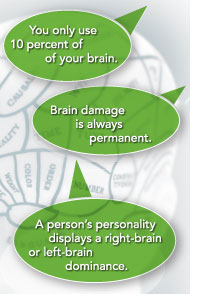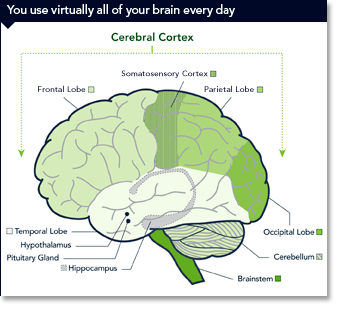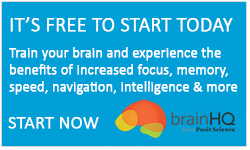 What is common among the three statements to the left?
What is common among the three statements to the left?
They are all myths and are believed to be true by most people. Some brain myths derive from partial truths while other myths have been born out of misinterpretations or because of someone needed a great sound bite. Regardless of their origin, these myths continue to be passed around as fact by people around the world.
The myths that are spread virally and treated as fact are usually those that appear to be backed by science. This is mostly because people are less likely to question the legitimacy of these myths because of the apparent “scientific sponsorship”. Since much of the brain and its functions are not fully understood, brain myths have a tendency to be even more challenging to demystify. Recent research has been able to discredit several brain myths as a result of what scientists have discovered about the brain.
Myth No. 1: Only 10% of your brain is actually used.
The Fact is: You use your entire brain
While its origins are uncertain, the myth that we only use ten percent of our brain has been shared as truth for a very long time. The factuality of this myth has been reinforced by misinterpretations and unsupported quotes from scientists, researchers, and laypeople over the past half century.
In actuality we use nearly our entire brain every day.
To illustrate brain use, imagine you are reading a book while eating a granola bar. While you are reading the words on each page your frontal lobes in the cerebral cortex are busy performing reasoning and thinking functions. At the same time, your parietal lobes are allowing you to enjoy your granola bar because these lobes are responsible for things like taste, texture detection, and smell. Meanwhile you’re able to process how you see the words in your book thanks to your occipital lobes and you are able to process the sounds that you hear, such as the rustling of the pages, because of your temporal lobes.
 At the same time your brain is handling all of these functions and actions, your motor area is making you blink, you are holding your granola bar because of your cerebellum. You are also maintaining your posture, breathing, digesting, and circulating blood around your body all as a result of your brainstem. Your pituitary gland is simultaneously controlling your water and sugar levels, metabolism and hormonal functions. Furthermore, if you happen to be outdoors on a chilly day, your hypothalamus is accountable for your shivering in the colder weather.
At the same time your brain is handling all of these functions and actions, your motor area is making you blink, you are holding your granola bar because of your cerebellum. You are also maintaining your posture, breathing, digesting, and circulating blood around your body all as a result of your brainstem. Your pituitary gland is simultaneously controlling your water and sugar levels, metabolism and hormonal functions. Furthermore, if you happen to be outdoors on a chilly day, your hypothalamus is accountable for your shivering in the colder weather.
Your hippocampus will help you store the words you are reading in your memory because this is the part of the brain responsible for transferring short-term memories to long-term memories. Ironically it is the part of the brain that is allowing you to remember this article about how much of your brain you use.
Myth No 2: Your personality displays whether you are right or left brained
The Fact is: The two sides of your brain depend on each other.
The myth that right-brain individuals are more creative or artsy and left-brain individuals are more logical and linear originated from legitimate science. While this was previously a scientific believe, new imaging technology has led to a discovery that the two sides of the brain are actually more interdependent than previously assumed.
It is believed that this myth originated back in the early 1800s when scientists noted that when an individual suffered an injury to one side of the brain, specific abilities were lost following the injury. Throughout the 1960s the brain myth was further strengthened when scientists began studying epilepsy patients who underwent surgeries to sever the connection between the left and right hemispheres in the brain. These studies discovered that the two hemispheres would be unaware of each other and unable to communicate when they were separated. In fact, when subjected to different stimuli, each hemisphere responded differently.
To illustrate this point, when one patient was asked what he wanted to do, his left brain responded with "draftsman" but his right brain with "automobile racer."
Contrary to popular believe and prior research, the left and right hemispheres in the brain are not as cut-and-dry as we thought. Brain scan technology has shed some light on the fact that the two hemispheres are actually quite complementary. Recent research has shown that functions and processes we thought took place in one hemisphere only, actually take place in both, such as language processing which was previously thought to have occurred in the left side only.
Furthermore, research and experiments have discovered that the right brain hemisphere doesn’t work independently of the left when it comes to space. In terms of spatial abilities, the right side processes your general sense of space and your left side handles specific locations and objects.
There is still a correlation between the sides of the brain and the sides of the body. Your left side of your brain controls the right side of your body and the right side of your brain controls the left side of your body. As a result of this brain and body relationship with regards to sides, if an individual suffers an injury to a particular side of the brain then the opposite side of the body will be impacted. For example, a left-hemisphere stroke can cause paralysis in the right leg.
Myth No 3: Brain damage is always permanent.
The Fact is: Our brain can repair itself or compensate for certain lost abilities; it can even generate new cells and neural pathways.
Previously it was believed that we were all born with a specific number of brain cells and damaging any of them or being born with fewer brain cells meant that your number of cells would be depleted forever. Until recent research discoveries, prominent neuroscientists believed this to be true and even believed that the brain could not be repaired once it was “broken”.
Many scientists have now been convinced to think in a different way regarding brain cells and brain damage. This is the result of new evidence that has brought to light the fact that your brain remains “plastic” throughout your life and can rewire or change itself as a response to learning new things. Amazingly the brain is able to generate new cells under certain circumstances. This process is called neurogenesis.
In 1998 scientists demonstrated the brain cell regeneration process by placing a substance in a group of terminal cancer patients that would identify dividing cells. The substance was located during post-mortem examinations attached to new cells in the hippocampus. In addition to demystifying the belief that we are born with a specific number of brain cells but also brings hope to the individuals who have suffered a brain injury that resulted from trauma or diseases.






 English
English
 Français
Français


